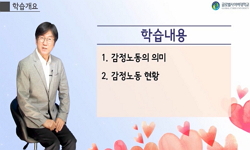After generalization of modern study, the status of emotion have been understood that is under the level of reason. but in modern days it’s discovered that emotion affects people’s realization process a lot as much as reason with development of b...
http://chineseinput.net/에서 pinyin(병음)방식으로 중국어를 변환할 수 있습니다.
변환된 중국어를 복사하여 사용하시면 됩니다.
- 中文 을 입력하시려면 zhongwen을 입력하시고 space를누르시면됩니다.
- 北京 을 입력하시려면 beijing을 입력하시고 space를 누르시면 됩니다.
부가정보
다국어 초록 (Multilingual Abstract)
After generalization of modern study, the status of emotion have been understood that is under the level of reason. but in modern days it’s discovered that emotion affects people’s realization process a lot as much as reason with development of brain science and appearance of the body and mind theory. the concept of emotion is identified as Qing 性 in orientalism that have been understanding the one of the important way of human’s global perception traditionally. This thesis will figure out the correlation revolved around the socio-cognitive interpretation between emotion and wisdom in Zhuangzi 莊子 which is the text of Daoism 道家. The part we have to focus on is that there are two emotion structures those are Wu-qing 無情 which is understood as the Way in Zhuangzi and the action structure of general emotions from like-dislike. and the structure of Knowledge related with emotion is also distinguished a Large Knowledge and a True Knowledge which are the positive way to understand, and a Small Knowledge which is the negative way to understand. the action structure of emotions in Zhuangzi that recognizes emotion as cognitive element seems to be related with cognitivism sentiments in philosophy. to restore the status of emotion as academic subject, the way to understand can be achieved from the analysis the point this is linked between two emotion structures and the knowledge in Zhuangzi. the result we can reach from this is that human’s pure emotion can be understood as human’s objective global perception.
국문 초록 (Abstract)
정(情) 자로 파악되는 동양사상에서의 감정 개념은, 전통적으로 인간의 세계인식의 중요한 방법 중 하나로서 이해되어왔다. 본 논문에서는 『장자』에서의 감정과 지의 상관관계를 인지주의적 해석을 중심으로 밝히고자 한다. 우리가 주목해야 할 부분은 『장자』에서는 도(道)로서 이해되는 감정인 무정(無情)과, 호오(好惡)에 의해 일어나는 일반적인 감정들의 작용구조 두 가지의 감정구조가 존재한다는 것이다. 그리고 감정과 연결된 지의 구조 역시 긍정적 이해방식인 대지(大知), 진지(眞知)와 부정적 이해방식인 소지(小知)로 구분된다. 감정의 학문 대상으로서의 지위를 복원하는 데 있어 우리의 이해방식은 『장자』에서 보이는 두 가지의 감정구조와 장자에서의 앎이 연결되는 지점에 대한 분석으로부터 이루어질 수 있다. 인간의 감정을 인지적인 요소로서 이해하고 있는 『장자』에서의 감정의 작용구조는 현대철학에서의 인지주의 감정론과도 연결 지을 수 있는 듯 보인다.
근대적 학문이 보편화되면서부터 감정의 지위는 이성보다 한 단계 아래에 놓여있는 것으로 이해되어왔다. 그러나 현대에 들어와서는 뇌과학의 발달과 인지주의적 심신론의 등장으로 감정...
근대적 학문이 보편화되면서부터 감정의 지위는 이성보다 한 단계 아래에 놓여있는 것으로 이해되어왔다. 그러나 현대에 들어와서는 뇌과학의 발달과 인지주의적 심신론의 등장으로 감정이 이성만큼이나 인간의 인식 과정에 많은 영향을 미침이 발견되었다.
정(情) 자로 파악되는 동양사상에서의 감정 개념은, 전통적으로 인간의 세계인식의 중요한 방법 중 하나로서 이해되어왔다. 본 논문에서는 『장자』에서의 감정과 지의 상관관계를 인지주의적 해석을 중심으로 밝히고자 한다. 우리가 주목해야 할 부분은 『장자』에서는 도(道)로서 이해되는 감정인 무정(無情)과, 호오(好惡)에 의해 일어나는 일반적인 감정들의 작용구조 두 가지의 감정구조가 존재한다는 것이다. 그리고 감정과 연결된 지의 구조 역시 긍정적 이해방식인 대지(大知), 진지(眞知)와 부정적 이해방식인 소지(小知)로 구분된다. 감정의 학문 대상으로서의 지위를 복원하는 데 있어 우리의 이해방식은 『장자』에서 보이는 두 가지의 감정구조와 장자에서의 앎이 연결되는 지점에 대한 분석으로부터 이루어질 수 있다. 인간의 감정을 인지적인 요소로서 이해하고 있는 『장자』에서의 감정의 작용구조는 현대철학에서의 인지주의 감정론과도 연결 지을 수 있는 듯 보인다.
참고문헌 (Reference)
1 이남인, "후설의 현상학과 현대철학" 풀빛미디어 2006
2 신승환, "지금 여기의 인문학" 후마니타스 2010
3 서복관, "중국예술정신" 동문선 1997
4 벤자민 슈워츠, "중국 고대 사상의 세계" 살림 2004
5 송영배, "제자백가의 사상" 현음사 1994
6 류성태, "장자의 죽음에 대한 연구" 범한철학회 24 : 2001
7 이강수, "장자Ⅰ" 길 2005
8 이진용, "장자(莊子)의 감정과 공감의 문제 - 무정(無情)의 논의를 중심으로" 한국철학사연구회 (46) : 41-65, 2015
9 이기동, "장자 外篇" 동인서원 2008
10 소병일, "이성과 감정의 이원론을 넘어 -현대 감정론을 통해서 본 헤겔 감정론-" 한국헤겔학회 (32) : 95-113, 2012
1 이남인, "후설의 현상학과 현대철학" 풀빛미디어 2006
2 신승환, "지금 여기의 인문학" 후마니타스 2010
3 서복관, "중국예술정신" 동문선 1997
4 벤자민 슈워츠, "중국 고대 사상의 세계" 살림 2004
5 송영배, "제자백가의 사상" 현음사 1994
6 류성태, "장자의 죽음에 대한 연구" 범한철학회 24 : 2001
7 이강수, "장자Ⅰ" 길 2005
8 이진용, "장자(莊子)의 감정과 공감의 문제 - 무정(無情)의 논의를 중심으로" 한국철학사연구회 (46) : 41-65, 2015
9 이기동, "장자 外篇" 동인서원 2008
10 소병일, "이성과 감정의 이원론을 넘어 -현대 감정론을 통해서 본 헤겔 감정론-" 한국헤겔학회 (32) : 95-113, 2012
11 이운구, "동아시아 비판 사상의 뿌리" 길 2004
12 오강남, "도덕경" 현암사 2001
13 공유진, "감정에 대한 인지주의의 수정과 확장" 철학연구소 (48) : 197-224, 2013
14 안병주, "譯註莊子(1∼4권)" 전통문화연구회 2008
15 劉笑敢, "莊子哲學" 소나무 2013
16 池田知久, "莊子 上" 講談社 2014
17 "莊子"
18 瀬川昌也, "知·情·意の発達と脳" 医学書院 60 (60): 2008
19 정우진, "感情: 感應의 인지" 한국동서철학회 (59) : 193-214, 2011
20 "孟子"
21 森三樹三郎, "上古より漢代に至る性命観の展開 : 人生論と運命観の歴史" 創文社 1971
22 김현수, "『장자』의 자유관 연구 : 제물론 을 중심으로" 동국대학교 동서사상연구소 10 : 2010
23 김명석, "『논어(論語)』의 정(情) 개념을 어떻게 이해할 것인가" 한국동양철학회 (29) : 147-171, 2008
동일학술지(권/호) 다른 논문
-
『呈才舞蹈笏記』의 소매춤[袖舞] 용어 분석과 유형 분류
- 인문예술학회
- 김미영
- 2015
-
- 인문예술학회
- 정석도
- 2015
-
- 인문예술학회
- 이시우
- 2015
-
- 인문예술학회
- 권오향
- 2015




 KCI
KCI








